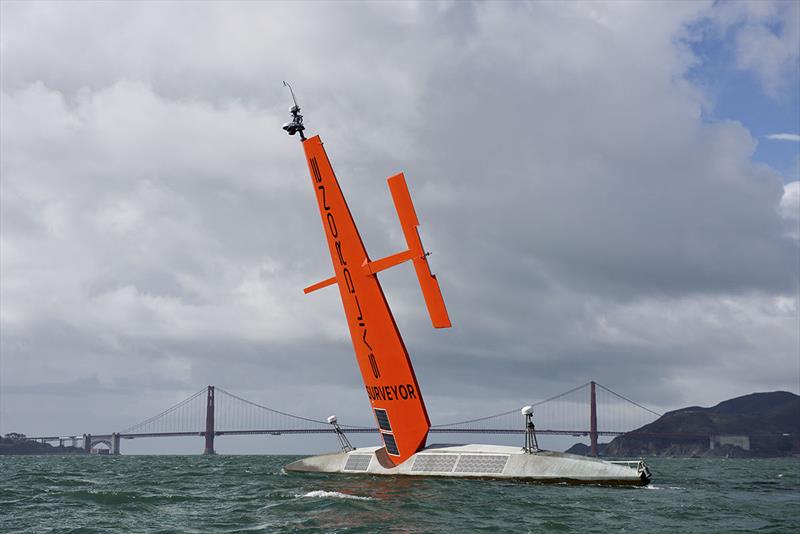
Saildrone fleet reaches new milestone: 1,000,000 nautical miles and 32,000 days at sea
by Saildrone 18 Oct 2023 09:52 UTC

Saildrone fleet of USVs has surpassed an incredible cumulative distance of 1,000,000 nautical miles during more than 32,000 days at sea © Saildrone
The accomplishment comes just 10 years after the first Saildrone USV crossed the Pacific Ocean and confirms Saildrone's position as the only proven long-range, long-endurance uncrewed platform.
On a windy day in October 2013, a small team of engineers and boatbuilders watched the first wind-powered ocean drone disappear over the horizon, bound for Hawaii 2,200 nautical miles away. That journey took 34 days.
Fast forward 10 years, and Saildrone's fleet of uncrewed surface vehicles (USVs), now 136 strong and scaling rapidly, has sailed 1,042,620 nautical miles and spent 32,438 days at sea—and counting.
"Evolving the Saildrone design, capabilities, and team has been an incredible journey," said Saildrone founder and CEO Richard Jenkins. "This million-nautical-mile milestone is a huge achievement in a relatively short time frame. It underscores the reliability we have achieved and confirms our unique position as the only proven long-range, long-dwell USV."
32,438 days at sea is equal to almost 89 years. 1,042,620 nautical miles is equivalent to sailing across the Pacific Ocean at the equator 95 times, circumnavigating the Earth 48 times, or traveling to the moon and back 2.5 times.
Proven by science, trusted by all
Powered primarily by renewable wind and solar energy, Saildrone USVs are equipped with state-of-the-science sensors that measure ocean environment parameters. From its origins in science and fisheries, Saildrone has expanded its capabilities to include ocean mapping, maritime security, and defense applications.
In 2015, Saildrone and the National Oceanic and Atmospheric Administration (NOAA)’s Pacific Marine Environmental Laboratory (PMEL) began a series of annual missions in the Arctic to test the integration of various sensors and push the platform to its limits. The Arctic region was selected due to the challenge of local operating conditions. The missions gathered measurements to identify ongoing changes to the Arctic ecosystem and how those changes may affect the food chain as well as large-scale climate and weather systems.
In 2017, Saildrone and NOAA PMEL launched a series of six-month missions to the Equatorial Pacific to test how unmanned surface vehicles (USVs) could augment the Tropical Pacific Observation System (TPOS) data collection and improve early predictions of major weather events like El Niño and La Niña. Saildrone’s TPOS mission is the longest-running mission to date, with 17 vehicles deployed over six years.
In 2019, Saildrone launched the first autonomous circumnavigation of Antarctica to collect important new data about the global carbon cycle. Equipped with a revolutionary wing designed to withstand the massive waves in the Southern Ocean, SD 1020 completed its 11,879 nautical-mile (13,670 miles) journey in 196 days. Only a few days later, another vehicle set a record for the fastest Atlantic crossing by a USV.
Saildrone expanded its vehicle capabilities to address new challenges like maritime security and ocean mapping for defense and commercial applications. In 2020, Saildrone performed a demonstration of machine learning capabilities. This demonstration led to the development of the 10-meter (33-foot) Voyager, specifically designed for ISR (intelligence, surveillance, reconnaissance), law enforcement and maritime safety, drug interdiction, border and harbor security, and monitoring illegal fishing.
The first Saildrone Surveyor, a 22-meter (72-foot) USV for deep ocean mapping, was launched in 2021 and sailed to Hawaii later that summer. The bathymetry data collected was shown to rival that of the most advanced ocean survey ships in use today—meeting or exceeding International Hydrographic Organization standards.
Saildrone also launched its first hurricane monitoring mission in 2021, deploying five vehicles with shorter, ruggedized wings. In September, SD 1045 sailed through the eyewall of Category 4 Hurricane Sam collecting data that revealed new insights about how hurricanes intensify. The vehicle spent 24 hours inside the storm, measuring 109.83 knots (126.4 mph) of wind speed, which was officially determined to be the “highest wind speed recorded by an uncrewed surface vehicle,” a new entry in the 2024 edition of the Guinness Book of World Records.
Today, Saildrone is building one mid-size 10-meter (33-foot) Voyager per week and one large-size 20-meter (65-foot) Surveyor per month. By harnessing the power of renewable energy and autonomous technology, Saildrone is revolutionizing the way ocean data is collected and utilized for science, commercial, and defense applications worldwide.